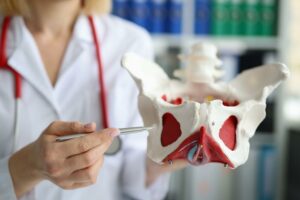As women approach menopause, they undergo significant hormonal changes that can impact various aspects of their health. One critical area often affected is bone health. The drop in estrogen levels during menopause can lead to a higher risk of osteoporosis, a condition characterized by weakened bones and an increased susceptibility to fractures. In this comprehensive guide, we will explore the relationship between menopause and osteoporosis and discuss effective osteoporosis menopause treatments and strategies.
Contents
What Is The Connection Between Osteoporosis And Menopause?
 The connection between osteoporosis and menopause lies in the hormonal changes that occur during this transitional phase in a woman’s life. Menopause is a natural biological process that marks the end of menstruation and fertility. Estrogen plays a crucial role in maintaining bone density and strength. It supports the activity of osteoblasts, cells responsible for building new bone tissue, while also inhibiting the activity of osteoclasts, cells that break down bone.
The connection between osteoporosis and menopause lies in the hormonal changes that occur during this transitional phase in a woman’s life. Menopause is a natural biological process that marks the end of menstruation and fertility. Estrogen plays a crucial role in maintaining bone density and strength. It supports the activity of osteoblasts, cells responsible for building new bone tissue, while also inhibiting the activity of osteoclasts, cells that break down bone.
When estrogen levels drop during menopause, this delicate balance is disrupted, leading to an increased rate of bone resorption (breakdown) compared to bone formation. As a result, women entering menopause often experience a decline in bone mineral density, making their bones more porous and fragile. This increased susceptibility to bone fractures characterizes osteoporosis. The bones, particularly the spine, hips, and wrists, become more prone to fractures due to decreased density and structural integrity.
The menopausal transition is a critical period for bone health assessment and intervention. Understanding this connection allows healthcare professionals and individuals to take proactive steps in preventing and managing osteoporosis. Regular bone density assessments and appropriate interventions can help reduce the risk of fractures and enhance overall bone strength in postmenopausal women.
How Can I Increase My Bone Density During Menopause?
Increasing bone density during menopause is crucial for preventing osteoporosis and maintaining overall skeletal health. Here are some strategies that may help enhance bone density during this stage:
- Calcium-Rich Diet
Ensuring an adequate intake of calcium is fundamental for maintaining and increasing bone density during menopause. Calcium is a vital mineral that forms the structural component of bones. Include dairy products like milk, cheese, and yogurt in your diet, along with leafy green vegetables such as kale and broccoli.
- Vitamin D Supplementation
Vitamin D is essential for the absorption of calcium. As natural vitamin D synthesis from sunlight diminishes with age, consider taking supplements to meet your body’s needs. Exposure to sunlight, particularly in the morning or late afternoon, can also help boost vitamin D levels naturally.
- Weight-Bearing Exercises
Engaging in weight-bearing exercises is crucial for stimulating bone formation. Activities like walking, jogging, and dancing, where your bones bear the load of your body weight, contribute to bone density. Aim for at least 30 minutes of weight-bearing exercise most days of the week.
- Quit Smoking
If you smoke, consider quitting. Smoking has been linked to decreased bone density and can contribute to fractures. Quitting smoking can have numerous health benefits, including positive effects on bone health.
- Limit Alcohol Consumption
Excessive alcohol consumption can negatively impact bone health. Limit your alcohol intake to moderate levels or, ideally, avoid it altogether. Moderation is key, as heavy alcohol consumption can interfere with calcium absorption and contribute to bone loss.
- Maintain a Healthy Body Weight
Achieving and maintaining a healthy body weight is crucial for bone health. Being underweight can increase the risk of bone loss and fractures. Focus on a balanced diet that provides essential nutrients and engage in regular physical activity to support overall health and maintain an appropriate weight for your body type.
Remember to consult with your healthcare provider before making significant lifestyle changes or starting new exercises, especially during menopause. They can offer personalized guidance based on your individual health needs and considerations.
What Are Some Best Osteoporosis Menopause Treatments?
 Osteoporosis menopause treatments often involve a combination of lifestyle modifications, nutritional interventions, and, in some cases, professional medical options. Here are some of the best osteoporosis menopause treatments available, particularly those that healthcare professionals may recommend:
Osteoporosis menopause treatments often involve a combination of lifestyle modifications, nutritional interventions, and, in some cases, professional medical options. Here are some of the best osteoporosis menopause treatments available, particularly those that healthcare professionals may recommend:
Hormone Replacement Therapy (HRT)
Hormone replacement therapy involves the use of estrogen, sometimes combined with progestin, to supplement the declining hormone levels during menopause. HRT helps maintain bone density by addressing the estrogen deficiency that contributes to bone loss. However, the decision to undergo HRT should be made based on an individual’s health history, risks, and benefits, and it’s essential to discuss this option with a healthcare provider.
Bisphosphonates
Bisphosphonates are a class of medications that inhibit bone resorption, helping to maintain or increase bone density. Commonly prescribed bisphosphonates include alendronate, risedronate, and zoledronic acid. These medications are often recommended for postmenopausal women with osteoporosis. It’s crucial to take bisphosphonates as directed and discuss any potential side effects with your healthcare provider.
Selective Estrogen Receptor Modulators (SERMs)
SERMs, such as raloxifene, act as estrogen agonists in some tissues and antagonists in others. They are used to prevent and treat osteoporosis by mimicking the positive effects of estrogen on bone without the associated risks. SERMs can be an option for women who cannot or choose not to take traditional HRT.
Denosumab
Denosumab is a monoclonal antibody that inhibits bone resorption by targeting a specific pathway involved in bone breakdown. It is administered through injection and is an alternative for individuals who cannot tolerate or choose not to take bisphosphonates.
Teriparatide (Parathyroid Hormone)
Teriparatide is a synthetic form of parathyroid hormone that stimulates bone formation. It is used in certain cases, especially when other osteoporosis medications are not well-tolerated or effective. Teriparatide is typically prescribed for a limited duration due to safety considerations.
Calcitonin
Calcitonin is a hormone that helps regulate calcium and phosphate levels in the body. It may be prescribed in certain situations, although its use is less common compared to other medications. Calcitonin is available in nasal spray or injection forms.
Bone-Forming Agents
Newer medications like romosozumab are considered bone-forming agents. They work by increasing bone formation and decreasing bone resorption. These medications may be considered for postmenopausal women at high risk of fractures.
Regular Monitoring and Follow-Up
Regular bone density testing (DEXA scans) is essential for monitoring the effectiveness of treatment and making adjustments as needed. Healthcare providers may also assess other factors, such as vitamin D levels, to ensure comprehensive bone health.
It’s crucial to note that the choice of osteoporosis menopause treatment should be individualized based on factors such as overall health, medical history, and specific risk factors. Consultation with a healthcare provider is essential. They will help to determine the most appropriate and effective treatment plan for each individual.
What Are Some Exercises To Help In Osteoporosis Menopause Treatments?
 Exercise is a crucial component of osteoporosis management during menopause. Here are some exercises recommended for osteoporosis menopause treatments:
Exercise is a crucial component of osteoporosis management during menopause. Here are some exercises recommended for osteoporosis menopause treatments:
Weight-Bearing Aerobic Exercises
- Walking: A simple and effective weight-bearing exercise that can be easily incorporated into daily life.
- Jogging or Running: Higher-impact activities like jogging or running can provide additional benefits. However, they should be adapted based on an individual’s fitness level and overall health.
Strength Training
- Weightlifting: Engage in weightlifting or resistance training exercises to strengthen muscles and bones. Focus on major muscle groups, including the hips, spine, wrists, and ankles.
- Resistance Band Exercises: Use resistance bands to add resistance to your strength training routine. These exercises can be adapted for various fitness levels.
Yoga
- Gentle Yoga: Many yoga poses focus on balance, flexibility, and strength, making them suitable for individuals with osteoporosis. Poses like the tree pose and warrior pose can be beneficial.
Pilates
- Pilates for Core Strength: Pilates exercises that target the core muscles can improve posture and stability, reducing the risk of falls.
Tai Chi
- Tai Chi for Balance: This low-impact exercise emphasizes slow, controlled movements that can improve balance and coordination. It’s particularly beneficial for reducing the risk of falls.
Dancing
- Low-Impact Dance: Participating in low-impact dance classes can be an enjoyable way to engage in weight-bearing exercise while improving coordination and balance.
Cycling
- Stationary Biking: Cycling on a stationary bike is a low-impact exercise that can be beneficial for cardiovascular health without putting excessive stress on the bones.
Balance Exercises
- Heel-to-Toe Walk: Practice walking in a straight line, placing the heel of one foot directly in front of the toes of the other.
- Single-Leg Stands: Stand on one leg for a few seconds, gradually increasing the duration as balance improves.
Overall, it’s crucial to tailor exercise routines to individual fitness levels and preferences. Before starting any new exercise program, especially for individuals with osteoporosis, it’s essential to consult with a healthcare provider or a qualified fitness professional. Hence, they can guide the most suitable exercises and adaptations, taking into account any specific health considerations or limitations.
Conclusion
In conclusion, navigating osteoporosis during menopause is about empowerment through knowledge and action. Understanding the connection between hormonal changes and bone health is the first step. Embracing a balanced lifestyle with a calcium-rich diet, weight-bearing exercises, and strength training can significantly contribute to bone density. Professional options should be explored under the guidance of healthcare providers.
Therefore, regular monitoring through bone density tests and consistent follow-up care are essential for effective management. Ultimately, by combining lifestyle modifications, professional guidance, and a proactive approach, women can enhance their bone health, and minimize the impact of menopausal changes. If you are facing menopause-related issues, menopause treatment at HerMantra can help. Book your free trial online menopause treatment session now.


